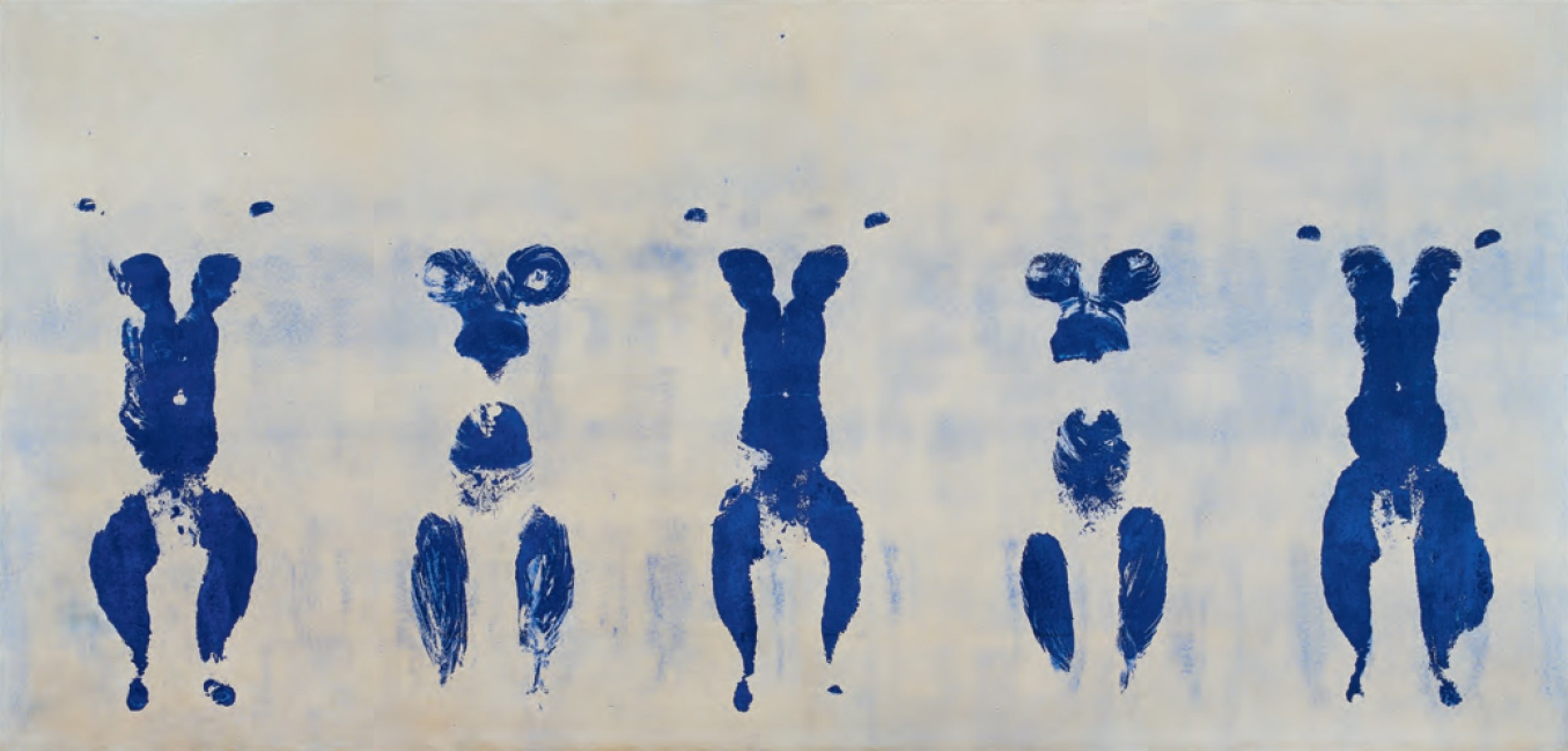THE WORLD IS BLUE
Yves Klein: In/Out Studio in WSJ Magazine
Photo: Shunk-Kender
Yves Klein: In/Out Studio in WSJ Magazine
Photo: Shunk-Kender
Yves Klein: In/Out Studio in WSJ Magazine
Photo: Shunk-Kender
(Anthropométrie de l'époque bleue (ANT 82), Yves Klein 1960.
Throughout the late 1950s to the early 1960s, the best avant-garde artist was Yves Klein (1928-1962). Born in Nice, France to a family of artists, Klein was full of inspiration and eventually taught himself his own skill (Restany 14). A man of new ideas, Klein was primarily concerned with humanity’s realm of sensibility, emotion, and perception. He believed that art was a language, creating pure emotion and fascination with spirituality and the eternal present. Yves Klein deeply explored the color blue. Consuming himself in it, Klein thought the phenomenological effect of its color “impregnates us the way happiness and the sense of fate impregnate us” (Restany 15). This concept was so distinctive during the time in France that it captured few and startled many. At the beginning, his main pursuit was strictly only examining the monochromatic composition of blue but he expanded his practice with pink and gold. Klein’s l’epoque bleue (Blue Period) began in 1957. He passionately created his work and exemplified his reputation of being an innovator. In his Anthropométries, Klein experiments with color and uses it to create the human form. The work itself are prints made with nude female bodies covered with blue paint then pressed and spread around on white paper. In his short life, Yves Klein’s true artistic vision was demonstrated in his Anthropométries and his philosophy of the color blue was shown through space and form.
“Through color, I feel the sentiment of complete identification with space; I am truly liberated" (Klein 138). To understand the philosophy of Yves Klein one must understand his fundamental ambitions. Color was an ~ experimentation ~ turned discipline for him. Pierre Restany, together with Klein and a few other artists. founded a movement called le nouveau realisme (New Realism). Members of this group claimed that their principles fused life with art and brought in a new awareness of returning to reality. This was unlike the Abstract Expressionists in the time period, who were concerned with emotionally driving abstraction. Klein used this movement to expand his own symbolic actions and started with his monochrome paintings. He found monochrome intoxicating. Creating his own blue color called IKB, or International Klein Blue, Klein defined his color palette as the Immaterial. When novices would ask him “but what does it (IKB 191) represent?" Klein would respond it is simply blue, by itself, representation of pure phenomenology (Chelsea Hotel Manifesto). Klein explains his thought with blue by describing it without any limits, by it being the actual visual nature in front of us (Klein 65). Blue is the color of the sky, paradise, and the sea. A cold color, it recedes from the viewer and stands alone in a work of art. It represents dreams, eternity, tranquility, distance, space and elevation (Traces De L'epoque Bleue). Klein was a writer and he would often express his take on color through written text. In the essay “My position in the battle between line and color,” he defined his concepts direct to viewers, saying that one should not read a painting but see one (Klein 55). After discovering the meaning of blue and exhibiting it in its solitude, he would then go on to use IKB in a variety of media. My personal favorite is La Couronne (1960) at the Menil Collection in Houston, TX.
La Couronne, Yves Klein 1960
Menil Collection
In 1960 he created the Anthropométries series. Klein directed a small orchestra while naked women covered in IKB, pressed and smeared their bodies on white paper. Klein would call the models his “living brushes.” During the performance, the models painted their bodies in two ways. Klein was dressed in a suit and staged himself as the conductor of the event. First Klein cued the music and voila! His performance was in work, the models would place the IKB paint on the front of their bodies, stand on wooden ledges and press their painted bodies against the paper, creating an imprint of their body but also forming the revolutionary figures of the New Realism movement (Anthropométrie de l'époque bleue (ANT 82). In the second series, the models dragged each other or their own body across the floor and create a long anatomical image (Anthropométrie sans titre (ANT 84). The depictions were later outlined with white paint. These women were historical imprints of the event. They are a generator of images, shapes and revealing themselves as evoked forms of other female nudes in the past (Traces De L'epoque Bleue).
The New Realism movement did not shape Yves Klein’s artistic career. It defined it. The Anthropométries series is an example of New Realism because it is questioning the perception of reality. Klein uses blue to convey this reality and combine its chromatic effect. An effect that has lived on forever.
Anthropométrie sans titre (ANT 84), Yves Klein 1960.
Watch the La Revolution Bleue
RESOURCES:
Pierre Restany, "Who Is Yves Klein?" (Houston: Institute for the Arts, Rice University, 1982) 14, 15.
Yves Klein, Overcoming the Problematics of Art: The Writings of Yves Klein (Putnam, CT: Spring Publications, 2007) 138.
IKB 191, Yves Klein 1962.
Yves Klein, “Chelsea Hotel Manifesto” (Yves Klein Archives: n.d.) 22 Apr. 2013.
Yves Klein "Objecthood and Reductivism" Sorbonne Lecture, June 3, 1959" (Fort Worth, TX: Modern Art Museum of Fort Worth, 2007) 55, 65.
Traces De L'epoque Bleue, prod. ARTE FRANCE, Palette Production, and Centre Georges Pompidou, dir. Alain Jaubert 1997, 30 minutes.
Anthropométrie de l'époque bleue (ANT 82), Yves Klein 1960.
Anthropométrie sans titre (ANT 84), Yves Klein 1960.




